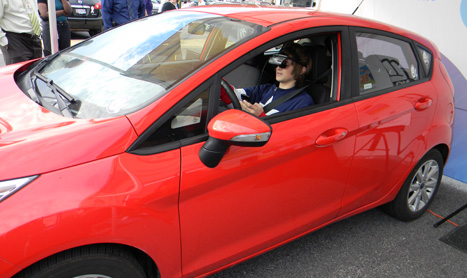GLEN BURNIE – Glen Burnie High School seniors mowed down pedestrians, exceeded the speed limit and careened off the road while texting and “driving” Wednesday, but fortunately no one was harmed in the virtual simulation.
The students were participating in an event to promote the dangers of distracted driving at the Maryland Motor Vehicle Administration headquarters in Glen Burnie.

At the event, co-hosted by AT&T as a part of its “It Can Wait” campaign, students played a virtual texting-while-driving game using a real car equipped with gas, brake and steering sensors, which were linked through a computer and displayed to the driver with a headset.
Students had to avoid hazards such as pedestrians in the crosswalk, stop lights, animals in the street and cars pulling out of driveways, all while texting. The results were not pretty: speeding, striking pedestrians and driving off the road.
In Maryland, “over 250 deaths occur as a direct result of distracted driving and over 5,000 vehicle crashes (occur) as a direct result of distracted driving,” according to Maryland MVA Administrator John Kuo.
“Maryland’s working toward a zero-death goal because every life in Maryland counts,” Kuo said. “These are (the) types of highway crashes — as a result of distracted driving — and fatalities that are preventable.”
Representatives from the Glen Burnie High School’s National Honor Society, Student Government Association, yearbook, newspaper and community service group, the Interact Club participated. The National Honor Society will develop a presentation based on the information they learned to show the rest of the student body, President Julianna Randazzo, 17, said.
Julianna has had her license for about a year and does not text and drive, thanks to commercials she’s heard about the dangers and another more personal experience.
“One of my mom’s friends was in an accident while someone was texting,” she said.
Julianna has friends who text and drive, but avoids riding with them.
“If they’re texting and I’m in the passenger seat, I won’t drive with them again.”
But she does offer to text for her friends who are driving in order to remain safe.
Student Government and Senior Class President Justin Mohammed, 17, has been driving for about six months and also opposes texting and driving.
“I signed a pledge for another school for their texting and driving campaign,” he said, “and since then I’ve wanted to bring one to our own school.”
Justin has been working with his school’s events coordinator to start his campaign and saw this event as a launch pad to promote the cause.
AT&T’s “It Can Wait” campaign was developed in 2009.
“We are reaching out — particularly focused on young people because they’re the ones that primarily use texting as a way of communicating,” AT&T’s Regional Vice President for External Affairs Denis Dunn said.
He said teens and people in their early 20s are more likely to use texting as their main form of communication and expect to offer timely responses to text messages.
“Regardless of how quickly you want to respond to somebody, when you are behind the wheel of a car, the focus has to be on driving,” he said, “because the consequences and the stakes are so high.”


You must be logged in to post a comment.